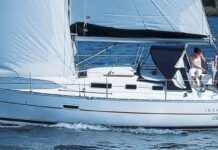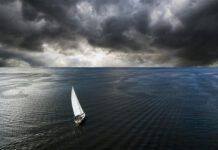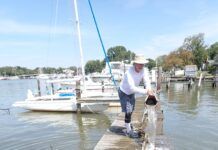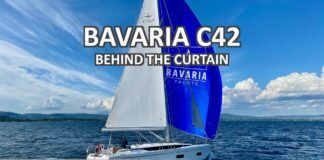Plastics vs. Weather
First of all, I want to say what a pleasure it is to be getting Practical Sailor. I am very pleased with your “realistic” editorials.
I wanted to make a comment on “Plastics vs. Weather” (PS, March) which briefly addressed an unpublished element from the field report article by the Dashews (“After 38,000 Miles,” same issue).
The caption on page 29 would lead one to believe that the Vetus Dorade cowls stink. Well, I can tell you that the Nicros and Taylor fenders and other soft plastic pieces do the same thing. The cowls on our new Island Packet 35 lasted about four years, until I couldn’t stand them any more. They were worse that those shown. This was after living aboard for all that time in the Pacific Northwest and San Diego (now there is some bad air).
Whose fault was it? Mine!
I replaced them with the same make, but I took care of them and they were like new after another 2 years (San Diego, Florida, and Annapolis). What was the difference? No ammonia, no brushes, no harsh cleansers, nothing that wasn’t mild to a material that can have plasticizers removed very easily. Ive seen fenders that were bubbling black gook for those very reasons.
The solution? Wash regularly with fresh water, and if necessary use a mild soap like Joy. Never use anything but a very soft cloth to wipe. I also put a wax on it, both inside and out for protection every 2 months or so, and my choice for that is 3M “One Step,” which I use sparingly, after I use the same rag to do the deck and/or hull. In the spring and fall I use the 3M “One Step” followed by 3M paste wax, and our hull after six years in the sun (never out of the water except to paint the bottom) is like new.
I wrote the following do’s and don’t’s for a local sailing groups newsletter:
Do:
1. Clean the boat hull and deck with a soft rag as often as possible to remove dirt and salt. Even a hand wipe works in most cases. Once a week at a minimum and just hosing off does not remove the dirt that sticks. Try it on your car and you can feel the surface change with just a hand wipe.
2. Make sure any soap (I use Joy only) is thoroughly rinsed from all surfaces (especially canvas and wood). If you wash dishes you’ll know just how much water it takes to get off too much soap-a little goes a long way.
3. If you have to scrub a tough spot, use a white soft scrub pad and re-wax the area. You’d be amazed what that 3M Fiberglass Cleaner and Wax will do with just a rag, though.
4. Touch up throughout the season, as necessary.
Don’t
1. Use a scrub brush on the hull or deck (especially wood). They should be banned from boat stores, in my opinion. They are harsh and scratch the gelcoat, paint, etc., and will open areas for dirt to reside.
2. Use harsh household cleaners or ammonia-based products on the boat. They harm waxed surfaces, can damage finishes (like gelcoat) and remove plasticizers from plastics like Dorades, rub rails, “glass” windows on dodgers, etc.
3. Let dirt/mold (those small black dots on the hull or deck) sit for very long. They will spread.
-Butler Smythe
Annapolis, MD
———-
Big-Three Owners Self-Define
Your recent article, “Three Big-Three 30s,” (April 1) stirred up quite a fuss on our unofficial web sites for Hunter, Catalina, and Beneteau owners. Discussion of the conclusions, attributed to builders and dealers, regarding owner personality types was particularly heated.
To enable a full airing of the topic, we followed your article with a survey about owners’ attitudes toward boat maintenance, which is what sparked most of the debate. Even assuming that owners frequenting these websites are more dedicated sailors (and probably more capable) than the norm, the results were both remarkably similar and tellingly different:
The following best represents my attitude toward boat maintenance:
I sail my boat, I do not fix it…
Hunter 2% Catalina 2% Beneteau 5%
I do the minor stuff but hire out the big jobs…
Hunter 30% Catalina 24% Beneteau 30%
I do all but the really techie jobs…
Hunter 48% Catalina 47% Beneteau 51%
Nobody touches my boat but me…
Hunter 20% Catalina 27% Beneteau 14%
(1038 owners responding)
This supports the conclusions of builders and dealers that Catalina owners are most likely to do any work required on their boats. However, contrary to their beliefs, Beneteau owners appear slightly less inclined to tackle the major projects, with Hunter owners polling somewhere in between.
As you can see, only a very small portion of owners claim to use the “credit card” method of boat maintenance.
Of course, surveys like this result in broad generalizations that do many owners a disservice. But, after observing several years of discussions among each group, we’re quick to make one generalization ourselves: Builders know their customers well. Brand loyalty (and repeat purchase) is clearly the rule and not the exception.
-Phil Herring
SailboatOwners.com
———-
Sail Care
Your April 15 issue had a PS Advisor item on the subject of sail care. I can recommend the firm Sail Care in Ford City, PA.They will clean and even recondition sails with a process which, as I understand it, puts the sizing back into the cloth. I sent them a main and two genoas and was pleased with the results.Look at www.sailcare.com.
-William Wright
Via e-mail
———-
Trimarans and Harbors
Regarding your PS Advisor, “To Fold or Not to Fold,” February 15, for about 10 years now I have been sailing Corsair trimarans, and for the last 5 years an F-31 which has a 22′ 5 beam. I have never found the beam to be a problem in either docking or anchoring situations. Here in New England I anchor in many crowded smaller harbors and I find the shallow draft of 16″ to be much more of an advantage than the 23′ beam is a detriment. We often anchor off by our lonesome even in crowded harbors, and are often more protected from wind and current as well.With a proper bridle the boat does not sail at anchor. Unlike monohulls, we sit with the wind more than the current.
Our preferred anchorages are close to a beach with the bow anchor out and stern on shore; with enough pitch to the beach we step from transom to dry sand, although usually ankle to knee deep water. Coming dockside like any boat requires some practice, preferably with daggerboard down and a steerable engine. There has never been a situation where I have needed to fold up to a narrower beam except going on and off the trailer. After all, we are only about 4′ wider on each side than your average modern 40′ monohull! This year I expect to have a Corsair 36, which has 25′ 7″ beam, and expect to go everywhere I would with my F-31.
Seriously, it is only a matter of getting used to it. Yes, there may be some tight harbors you will stay away from, but I would guess any 50’+ monohull would stay away from those same harbors.
-Bob Gleason
Wareham, MA
Bob Gleason of the Multihill Source is a dealer of Corsair and Farrier trimarans, and has many years of experience cruising multihulls and racing them at the championship level.
———-
Jib Cloth Strength
I just read your PS Advisor comments in the February 15 issue concerning sailing under jib alone. I believe one issue was not addressed: One mustalso consider the wind strength for which the jib was designed whensailing under jib alone. Even though the rigging and mast may be ableto handle the loads sailing under jib alone in a strong breeze, if thewindspeed is above the rating of the jib, the sail fabric/shape may getdamaged.
-Dave Biggs
San Francisco, CA
———-
Search Globally, Shop Locally
Here’s an interesting example of comparison shopping on the Internet. (See “Website Shopping,” October 15, 2001.) I needed to replace the 12-volt electrical distribution panel on my boat, and a product from Blue Sea Systems looked like the perfect fit for the space where the existing panel is. I checked the price on each of the following websites and was rather surprised to find such a wide range:
SailNet.com $273.69
BoatersWorld.com $299.99
WestMarine.com $379.99
I could not find the same product in the BoatUS online catalog, but in the paper catalog the price is $329.99.
I usually shop at “The Chandlery,” which is the locally owned marine store in Santa Barbara Harbor. They have a policy of matching any otherretailer’s price as long as you can show it to them in a catalog or ad.
They don’t have everything in stock, of course, but will order anything from any catalog and don’t charge for the shipping. Most things arrive within a week, often in a couple days. It’s certainly the best of all worlds-I paythe lowest price offered by any of the big catalog/online dealers, withoutany shipping charges, and support a local business that has been around for a long time and has done a lot for the boating community.
-David C. Turpin
Via e-mail
———-
Chart Chip Prices
I’m a long-time subscriber of PS and enjoy the research and articles. I had a thought for a future PS article: GPS chart chip prices. Last year I purchased a Standard Horizon 160 GPS at West Marine before doing some coastal cruising, and was astounded at the chart chip prices. Small charts (Newport and Block Island) were up to $200 and the areas up to Boston were $350! Paper charts are a fraction of these prices.
I purchased the least expensive chip for the GPS, chided myself for not doing more homework before the GPS purchase, then carried all my paper charts back on board.
-Hank Kniskern
Newport, RI
———-
Mac Nav, and What Backs Up What Around Here
Your otherwise excellent February 1 article on navigation software contained the unfortunate oversight of not mentioning PC/Mac compatibility issues. I had to learn the hard way a year ago before leaving for a five-month sail to SE Alaska. Having bought a Nobletec product for use on my Macintosh G3 laptop with a PC emulation program, I was told condescendingly by Nobletec that they design their software for PC use only, do not intend to make them Macintosh compatible, and further, that they would refuse tech support if their product was used on a Mac. Period. I felt Nobletec needed an attitude adjustment and some competition.
Nobeltec may still have their attitude, but I’ve found their competition, MaxSea, to be a powerful navigation program. It installs easily on the Mac, and comes with excellent, attentive, technical support. Macintosh sailors had little to choose from until MaxSea came to the States.
-Gifford T. Jones
Seattle, WA
———-
I enjoyed reading your report on navigational software, as I am in the market for a computerised charting program and was pleased that you did all the research and testing for me. The information in the article is very valuable to someone contemplating making a first-time purchase and will make the decision process a lot easier.
I noticed at the conclusion of this article, and every other article that I read about electronic navigation, that the statement is always made that these devices are no substitute for paper charts. If this is the case, then why do you think people buy these programs when they still have to use mechanical means of navigation and paper charts? Is the entertainment value of the electronics the reason people buy them, or should we be concerned about a loss of power or such to the devices?
I can understand the reason behind having paper charts as a backup for the computerised versions, but see no need to refer to them unless the electronic version ceases to operate, in which case I would call the paper charts a supplement to the electronic charts.
-Vic Sinclair
Via e-mail
———-
Single-Burner Stove Notes
BoatUS no longer carries the Glomate 1600. (PS, March). They now carry a similar model that is stainless steel and costs more-$79.99.
-Dave Lochner
Via e-mail
Kenyon International has issued a recall of Kenyon model B23000 and/or B23001 Express stoves shipped prior to April 4, 2001. There could be a defect that “may lead to unsafe operating conditions.” Kenyon requests that “all model B23000 and B23001 stoves be returned to us for inspection and free replacement of the faulty component. New Kenyon Express stoves B23100 and B23101 are not being recalled.”
Kenyon has established a toll-free number to respond to questions on this issue: 866/585-7377.
“New stoves must be pre-certified by calling and obtaining a Return Authorization number. Used stoves may be sent without prior approval. Butane gas canisters must be removed before shipment.
“Stoves should be returned to Kenyon International, Attn: Express Recall, 8 Heritage Park Road, Clinton, CT 06413. Please do not ship stoves to the P.O. box address.”
———-
Correction
In the three-boat review in the April 1 issue, we said that all three boats were constructed to meet CE Standard B, “the designation for coastal cruisers in Europe.” In fact, Standard B is for “Offshore,” and the Catalina 310 was constructed to Standard A, “Ocean.”
———-
Where Credit Is Due
To C. Sherman Johnson Marine, East Haddam, CT:
“The four Delrin sheaves that fit into my CS Johnson split backstay adjuster finally gave out on me as I was measuring the amount of mast bend in my rig for a new main. I tried to order replacement sheaves from West Marine and Pyacht.com for four days with little success. These sheaves are inexpensive (less than $10.00 for a set of four) and are clearly listed on the Johnson marine website as being in production and available. However, the responses I received from West Marine were, “That part is out of production. It would be cheaper to buy a whole new unit anyway. I can sell you that.” The Pyacht representative told me that he couldn’t answer the availability question and that they would get back to me via e-mail. (I’m still waiting.) I put a call into Johnson Marine and was connected to their technical sales rep (Kurt), and before I could even ask if the company would sell me a set of sheaves directly, he was asking me for my address so that he could drop a supply of them in the mail for me (‘for free of course, as they typically give these away at most trade shows’). It’s great to know that the idea of world-class customer service is still alive and well at Johnson Marine.”
-Daniel Doolittle
Hayes, VA
To Tasco, Miramar, FL:
“During a sailing trip, a guest accidentally dropped my four-year-old Tasco Offshore 36 binoculars, damaging their ability to focus and rendering the internal compass inoperative as well. I sent the binoculars to Tasco with a cover letter explaining the cause of the damage, assuring Tasco they bore no responsibility for the failure, and I requested an estimate for repair. Within a few weeks, I received a package from Tasco containing a brand-new pair of Offshore 36 binoculars at no charge.
“I was astonished by Tasco’s extraordinary consideration. They have earned themselves a permanent customer with their terrific products and exceptional customer relations.”
-Ed Lange
Delmar, NY
To Seoladair Ltd., La Grange, IL:
“I manage an old campaigner, Blue Bayou, J/36 hull No. 2. This boat has been ‘rid hard and put to bed wet’ since 1981. The BoomKicker failed after about 5-6 years of use. When notified by e-mail, Ted Corlett at Seoladair first apologized and then sent all the replacement parts within a few days at no charge except for handling and shipping. That’s what I call product support.”
-Joe Valinoti
Oriental, NC





































